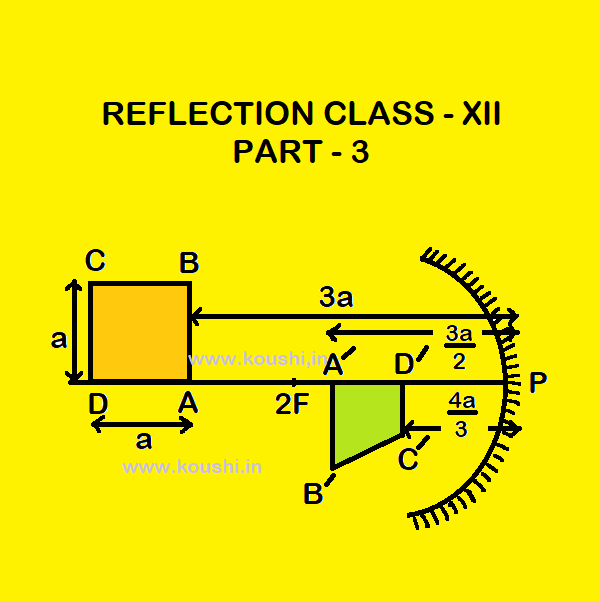Some basic numericals based on mirror formula are given in the blog of ‘Reflection through curved surface class – X‘. To get the numericals click the given button.
More concepts for the preparation of competitive examinations are given below.
1. A rod of length l lies along the principal axis of a concave mirror of focal length l in such a way that the end of the rod closer to the pole of the mirror is 2l away from it. Find the length of image of the rod.
As the closer end of the rod is placed at the centre of curvature (point C) of the mirror therefore this end produces real image at centre of curvature.
The other end (point A) of the rod lies in between 2F and infinity. Therefore, point A creates real image in between F and 2F. If A/ is the image of point A, then object distance PA = u = – 3l
Image distance PA/ = v
Focal length PF = – l
Using mirror formula we get, ![]()
Or, ![]()
Or, ![]()
![]() v = -1.5l
v = -1.5l
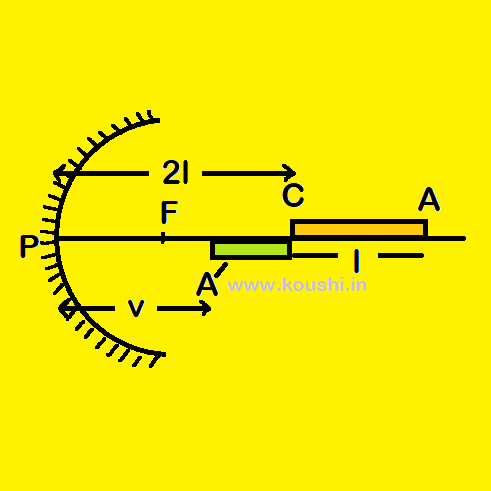
Therefore the length of image of the rod is A/C = PC – PA/ = 2l – 1.5l = 0.5l.
2. The sun (diameter d) substances an angle ![]() radian at the pole of a concave mirror of focal length f. Calculate the diameter of the image of the sun formed by the mirror.
radian at the pole of a concave mirror of focal length f. Calculate the diameter of the image of the sun formed by the mirror.
As the sun is at a far distance from earth then object distance u = ![]() . Therefore, the image of the sun is at the focus of mirror. So, v = f. The angle subtended by the incident and reflected ray at the pole of the mirror is very small. Therefore, tan
. Therefore, the image of the sun is at the focus of mirror. So, v = f. The angle subtended by the incident and reflected ray at the pole of the mirror is very small. Therefore, tan![]() =
= ![]() .If the diameter of the image of the sun is A/B/ then from the diagram,
.If the diameter of the image of the sun is A/B/ then from the diagram, ![]()
Or, ![]()
![]()
![]() .
.
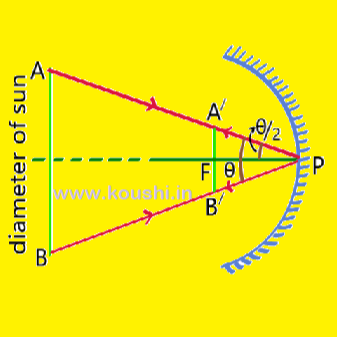
3. A square object of each side a is placed on the principal axis of a concave mirror of focal length a in such a way that the point A of the object is at a distance 3a from the pole of the mirror. Calculate the area of the image of that object.
If we consider the side AB as object then, object distance PA = u = – 3a, image distance PA/ = v, focal length f = – a
Using mirror formula we get, ![]()
Or, ![]()
Or, ![]()
Or, ![]()
![]() v = – 1.5a
v = – 1.5a
The magnification m = – ![]() =
= ![]()
Or, – ![]() =
= ![]()
![]()
![]() .
.
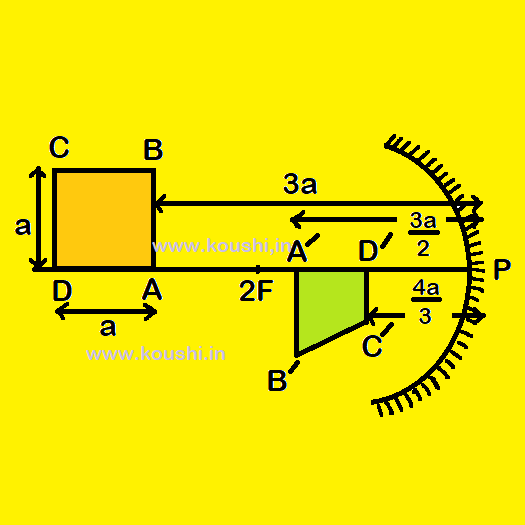
If we consider DC as the object then, object distance PD = u = – 4a, image distance PD/ = v, focal length f = – a.
Using mirror formula we get, ![]()
Or, ![]()
Or, ![]()
Or, ![]()
![]() v = –
v = – ![]()
The magnification m = – ![]()
Or, – ![]()
![]()
![]()
The length of side A/D/ = PA/ – PD/ = ![]()
The area of the image = area of trapezium A/B/C/D/ = ![]() [A/B/ + C/D/]A/D/ =
[A/B/ + C/D/]A/D/ = ![]() .
.
4. Focal length of convex mirror (M1) is 10 cm and that of concave mirror (M2) is 15 cm. Find the position of image of an object O placed in between two mirror as shown in figure. Take the first reflection from M1.
For mirror M1, object distance P1O = u = -10 cm, image distance P1I = v, focal length f = +10 cm.
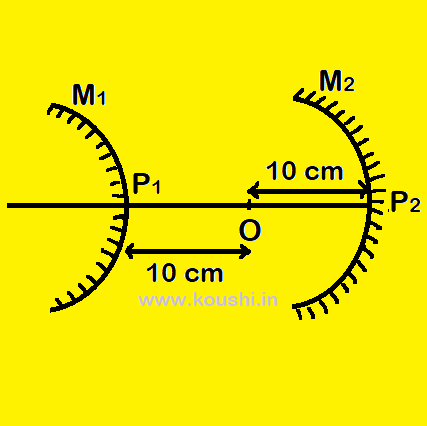
Using mirror formula we get, ![]()
Or, ![]()
![]() v = + 5 cm.
v = + 5 cm.
The image at point I is virtual and this is considered as the object for mirror M2.
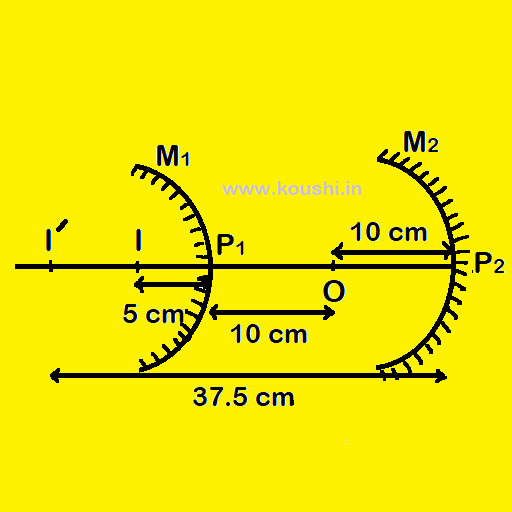
For mirror M2, object distance P2I = u = -25 cm, image distance P2I/ = v, focal length f = -15 cm.
Using mirror formula we get, ![]()
Or, ![]()
![]() v = -37.5 cm
v = -37.5 cm
Therefore the image position after second reflection is 37.5 cm from the pole of concave mirror.
5. The focal length of a concave mirror is f. A plane mirror is placed at a distance of 2.25f from the pole of the concave mirror facing towards it. Where should an object be placed between these mirrors and facing both mirrors so that it’s virtual image in the plane mirror coincides with the real image in concave mirror.
Let us consider the object O is placed at a distance x from the pole of the concave mirror.
The distance between object and plane mirror is (22.5f – x)
Using mirror formula we get, ![]()
Object distance PO = u = -x
Image is formed at point I. So image distance = v
Focal length PF = -f
![]()
Or, ![]()
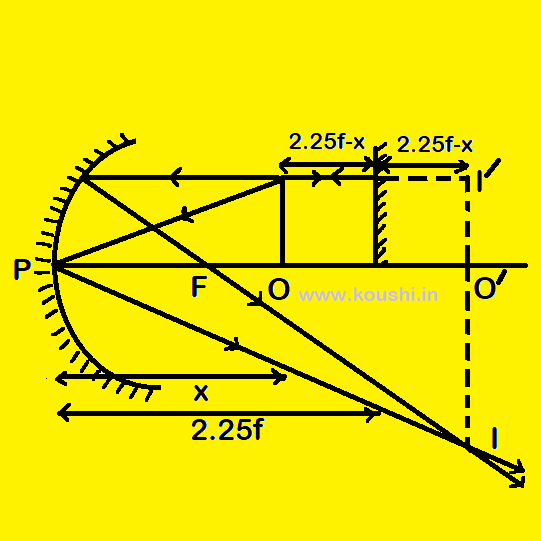
![]() v = –
v = – ![]() [negative sign indicates that the image is in front of the mirror as it is real]
[negative sign indicates that the image is in front of the mirror as it is real]
For plane mirror the distance between object and image is 2(2.25f-x) = 4.5f – 2x.
Therefore, x + (4.5f – 2x) = ![]()
Or, 4.5f – x = ![]()
Or, 4.5fx – x2 – 4.5f2 + xf = fx
Or, x2 – 4.5fx + 4.5f2 = 0
![]() x =
x = ![]() =
= ![]()
So, x = 1.5f [x = 3f is not possible as the distance between mirrors is 2.25f].
6. An erect object O is placed on the principle axis at a distance of 3f from the pole of a concave mirror of focal length f. A plane mirror is placed perpendicular to the principal axis at the focus of the concave mirror as shown in figure. Find the position and nature of the final image formed.
After reflection from the concave mirror we get image at point I. This image is the virtual object for plane mirror.
Using mirror formula for concave mirror we get, ![]()
Object distance u = -3f, image distance = v, focal length = -f
Or, ![]()
Or, ![]()
Or, ![]()
![]() v = – 1.5f
v = – 1.5f
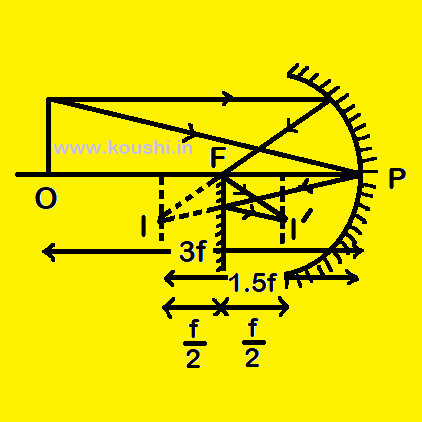
The distance between the virtual object I and plane mirror is 1.5f – f = 0.5f.
As the object is virtual for plane mirror so image at I/ is real. The image distance from plane mirror is 0.5f.
Therefore, the final image produced 0.5f from the pole of the concave mirror as plane mirror is placed at the focus of it.
Click the button to go to the next part of this chapter.
Click the button to go to the previous part of this chapter.
